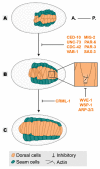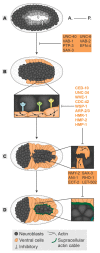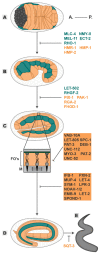Game of Tissues: How the Epidermis Thrones C. elegans Shape
- PMID: 32182901
- PMCID: PMC7151205
- DOI: 10.3390/jdb8010007
Game of Tissues: How the Epidermis Thrones C. elegans Shape
Abstract
The versatility of epithelial cell structure is universally exploited by organisms in multiple contexts. Epithelial cells can establish diverse polarized axes within their tridimensional structure which enables them to flexibly communicate with their neighbors in a 360° range. Hence, these cells are central to multicellularity, and participate in diverse biological processes such as organismal development, growth or immune response and their misfunction ultimately impacts disease. During the development of an organism, the first task epidermal cells must complete is the formation of a continuous sheet, which initiates its own morphogenic process. In this review, we will focus on the C. elegans embryonic epithelial morphogenesis. We will describe how its formation, maturation, and spatial arrangements set the final shape of the nematode C. elegans. Special importance will be given to the tissue-tissue interactions, regulatory tissue-tissue feedback mechanisms and the players orchestrating the process.
Keywords: C. elegans; epidermal-muscle axis; epidermal-neuroblast axis; epithelial morphogenesis.
Conflict of interest statement
The authors declare no conflict of interest. The funders had no role in the design of the study; in the collection, analyses, or interpretation of data; in the writing of the manuscript, or in the decision to publish the results.
Figures



References
-
- Koh K., Rothman J.H. ELT-5 and ELT-6 are required continuously to regulate epidermal seam cell differentiation and cell fusion in C. elegans. Development. 2001;128:2867–2880. - PubMed
Publication types
LinkOut - more resources
Full Text Sources

